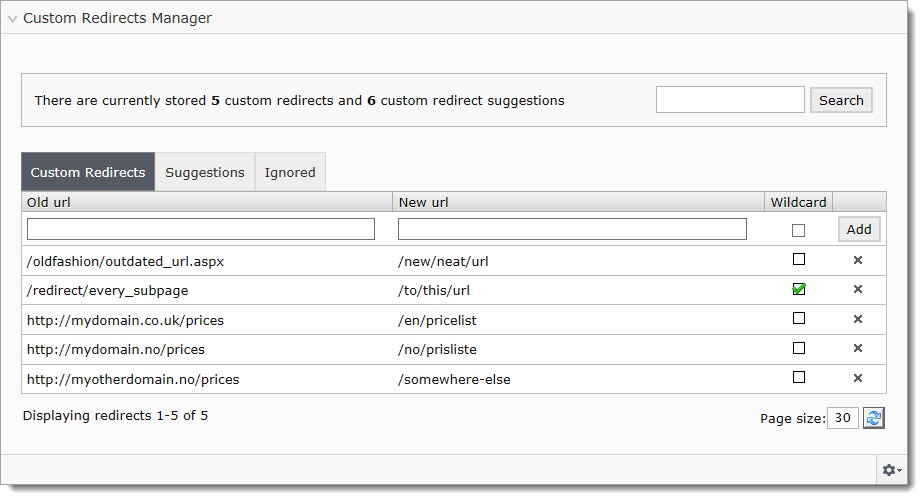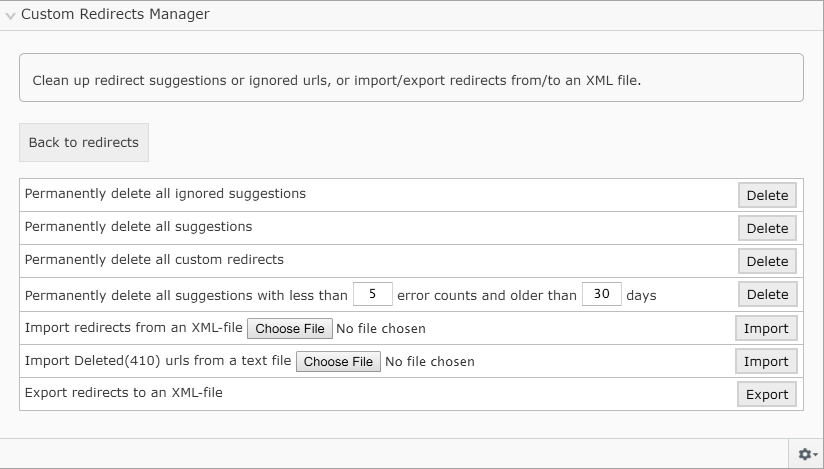Important Security Notice!
The default notfound.aspx page has an XSS vulnerability. If you are using this page, please change it according to this commit.
404 Handler for EPiServer
Description
For ASP.NET 5+ and Episerver/Optimizely 12+ see: https://github.com/Geta/geta-notfoundhandler
The popular 404 handler for EPiServer, enabling better control over your 404 page in addition to allowing redirects for old URLs that no longer works.
The perfect companion if you're transitioning to EPiServer from another system and cannot keep the URL structure, or plan to do major re-structuring of your content.
Features
- The 404 handler stores the redirects in the database, not web.config. Editors can add redirects without any deployments.
- All redirects are edited in the gadget as shown above. After the add-on is installed and a proper 404 page has been created, no changes to the application is needed to add new redirects.
- You can import and export redirects as XML from the admin interface.
- Handles partial and "full" URLs and can redirect out of the site by using fully qualified URLs for the "New url" field.
- Supports wildcard redirects.
- By using fully qualified URLs in the "Old url" field, they will only apply for that specific site. Editing redirects is done for all sites in the same UI.
- You need to be authorized to work with the gadget, and have access to edit mode, but there is no restriction on which editors can edit.
Installation
Install-Package Geta.404Handler
The package can be found in the EPiServer Nuget Feed.
Configuration
When installed, the following sections are added to your web.config:
<configSections>
<section name="bvn404Handler" type="BVNetwork.NotFound.Configuration.Bvn404HandlerConfiguration, BVNetwork.EPi404" />
</configSections>
<bvn404Handler handlerMode="On">
</bvn404Handler>
<system.webServer>
<httpErrors errorMode="Custom" existingResponse="Replace">
<remove statusCode="404" />
<error statusCode="404" path="/notfound.aspx" responseMode="ExecuteURL" />
</httpErrors>
</system.webServer>
<episerver.shell>
<protectedModules>
<add name="BVNetwork.404Handler" />
</protectedModules>
</episerver.shell>You can turn off the redirects by setting handlerMode to Off.
The httpErrors section is responsible for showing a custom 404 page. If you do not already have this section in your config, it will be added with the default settings as shown above. If the section exists, it will not be changed, and you might have to change it manually.
Important! errorMode needs to be set to Custom and existingResponse needs to be set to Replace, or the 404 page will not be shown, or will only be shown for URLs not ending with .aspx.
Make sure that you have BVNetwork.404Handler added as a protected module. The NuGet package has automatic Web.config transformation which adds it but sometimes it does not.
Important! If you notice that 404 page is hanging for a long time, then you might need to add this configuration to the Web.config:
<applicationSettings globalErrorHandling="Off" />Read more here: https://world.episerver.com/support/Bug-list/bug/CMS-1119
Logging
Suggestions for 404 rules require 404 requests to be logged to the database.
Logging of 404 requests is buffered to shield your application from Denial of Service attacks. By default, logging will happen for every 30'th error. You can edit the bvn404Handler section in web.config and set bufferSize="0" to log the errors immediately. This is not recommended as you will be vulnerable to massive logging to your database. You can control how much you would like to log by specifying a threshold value. This value determines how frequent 404 errors are allowed to be logged.
Important! Even if the threshold is set low, you can still receive a lot of requests in the 404 log. In the Admin view (follow "Administer" link in gadget) you can delete suggestions (logged 404 requests). You can find all the logged items in the BVN.NotFoundRequests table in your CMS database if you want to manually clear the logged requests (this will not remove any redirects).
<bvn404Handler handlerMode="On" logging="On" bufferSize="30" threshold="5" logWithHostname="false">
</bvn404Handler>logging: Turn logging On or Off. Default is On
bufferSize: Size of memory buffer to hold 404 requests. Default is 30
threshold: Average maximum allowed requests per second. Default is 5
- Example 1:
- bufferSize is set to 100, threshold is set to 10
- Case: 100 errors in 5 seconds - (diff = seconds between first logged request and the last logged request in the buffer).
- 100 / 5 = 20. Error frequency is higher than threshold value. Buffered requests will not get logged, the entire buffer will be discarded.
- Example 2:
- bufferSize is 100, threshold is 10
- Case: 100 errors in 15 seconds
- 100 / 15 = 6. Error frequency is within threshold value. Buffered requests will get logged.
If the bufferSize is set to 0, the threshold value will be ignored, and every request will be logged immediately.
logWithHostname: Set to true to include hostname in the log. Useful in a multisite environment with several hostnames/domains. Default is false
Specifying ignored resources
By default, requests to files with the following extensions will be ignored by the redirect module: jpg,gif,png,css,js,ico,swf,woff
If you want to specify this yourself, add ignoredResourceExtensions to the configuration:
<bvn404Handler handlerMode="On"
ignoredResourceExtensions="jpg,gif,png,css,js,ico,swf,woff,eot,otf">
</bvn404Handler>Restricting access to the Custom Redirect Manager
The Custom Redirect Manager is an Episerver gadget. Access to it can be controlled by configuring the dashboard in the Web.config.
<episerver.shell>
<viewManager>
<securedComponents>
<add definitionName="BVNetwork.NotFound.Controllers.NotFoundRedirectController" allowedRoles="Administrators" />
</securedComponents>
</viewManager>
</episerver.shell>For more info, check - Configuring the dashboard.
Import
For details see Import redirects for 404 handler article.
Custom 404 Page
You probably want to change the path to the 404 page to something else, typically a view in your project, or even a page in Episerver. Example:
<error statusCode="404" path="/Error/Error404" responseMode="ExecuteURL" />In this case, the /Error/Error404 is a MVC Action (Error404) on a Error controller. This will work out of the box (you no longer need Mark Everard's BVN.404Handler.MvcContrib package), but the Http status code will be 200, not 404. You can set this status code yourself, or decorate the Action with the NotFoundPage attribute.
Example:
public class ErrorController : PageControllerBase<PageData>
{
[BVNetwork.NotFound.Core.NotFoundPage.NotFoundPage]
public ActionResult Error404()
{
// Custom implementation
ErrorPageViewModel model = GetViewModel();
// The Action Filter will add the following to the ViewBag:
// Referrer, NotFoundUrl and StatusCode
model.NotFoundUrl = ViewBag.NotFoundUrl;
model.Referer = ViewBag.Referrer;
return View("Error404", model);
}
}The NotFoundPageAttribute action filter will set the http status code to 404 and populate the ViewBag with the following properties: Referrer, NotFoundUrl and StatusCode. You can use these properties in your view or for additional logging.
The filter will also attempt to set the language by matching the language segment in the beginning of the URL (if used.)
Custom Handlers
If you need more advanced or custom logic to create redirects, you can implement an INotFoundHandler.
- Create a class that implements
BVNetwork.NotFound.Core.INotFoundHandler - In the
public string RewriteUrl(string url)method, add your custom logic - Register the handler in web.config:
<bvn404Handler handlerMode="On">
<providers>
<add name="Custom Handler" type="Your.Name.Space.YourClass, YourAssemblyName" />
</providers>
</bvn404Handler>This is especially useful for rewrites that follow some kind of logic, like checking the querystring for and id or some other value you can use to look up the page.
Here is an example using EPiServer Find to look up a product by code:
public class CustomProductRedirectHandler : INotFoundHandler
{
public string RewriteUrl(string url)
{
if(url.Contains("productid"))
{
// Give it a thorough look - see if we can redirect it
Url uri = new Url(url);
var productId = uri.QueryCollection.GetValues("productid").FirstOrDefault();
if (productId != null && string.IsNullOrEmpty(productId) == false)
{
SearchResults<FindProduct> results = SearchClient.Instance.Search<FindProduct>()
.Filter(p => p.Code.MatchCaseInsensitive(productId))
.GetResult();
if (results.Hits.Any())
{
// Pick the first one
SearchHit<FindProduct> product = results.Hits.FirstOrDefault();
return product.Document.ProductUrl;
}
}
}
return null;
}
}Note! Make sure the code you add has good performance, it could be called a lot. If you're querying a database or a search index, you might want to add caching and perhaps Denial Of Service prevention measures.
Troubleshooting
The module has extensive logging. Turn on debug logging for the BVNetwork.NotFound namespace in your episerverlog.config:
<logger name="BVNetwork.NotFound"
additivity="false">
<level value="All" />
<appender-ref ref="debugLogAppender"/>
</logger>Usage
Wildcards
If you want to redirect many addresses below a specific one to one new URL, set this to true. If we get a wild card match on this URL, the new URL will be used in its raw format and the old URL will not be appended to the new one.
For example, if we have a redirect: /a to /b, then:
- with wildcard setting it will redirect
/a/1to/b - without wildcard setting it will redirect
/a/1to/b/1
Sandbox App
Sandbox application is testing poligon for pacakge new features and bug fixes.
CMS username: epiadmin
Password: 3p!Pass
Contributing
If you can help please do so by contributing to the package! Reach out package maintainer for additional details if needed.




